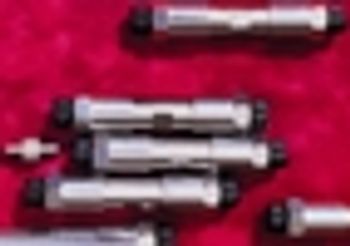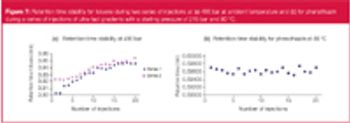
A professor from the University of Pittsburgh received one of the most distinguished awards at the Pittsburgh Conference on the third day of Pittcon 2008 from New Orleans.

A professor from the University of Pittsburgh received one of the most distinguished awards at the Pittsburgh Conference on the third day of Pittcon 2008 from New Orleans.

Well, it's Pittcon Day 2, and I followed the suggestion of LCGC Columnist John Hinshaw and attended session 410, "Food Science: UV-Vis, NIR, AA, LC, GC, and Electric Nose."

Monday's "General Interest: LC/GC" session delved into a wide array of new techniques and discoveries in the scientific and academic LC/GC communities.

The 2008 Chromatography Forum of Delaware Valley Dal Nogare Award was presented Monday morning to John G. Dorsey, the Katherine Blood Hoffman Professor of Chemistry at Florida State University, by Mike Koenigbauer, President of the Chromatography Forum of Delaware Valley.

Four years ago, problems were slightly different for HPLC users. However, one main problem remains the same and will continue to remain the same.

Good Morning and welcome to Day 2 of LCGC's coverage of Pittcon 2008 from New Orleans, Louisiana. We have already seen many informative and innovative press conferences and technical sessions, as the rate of technical development in the field of analytical chemistry continues to advance at a staggering pace.

The city of New Orleans has a rich history of merging French and American art, from the iconic fleur-de-lis to the works of Edgar Degas. Unfortunately, sometimes art, whether it's a painting, book, or some other medium, gets damaged due to unforeseen disasters. It is the job of the scientist to pursue the restoration of such precious objet d'art. These types of art recovery efforts were described in the session "Science for Art" at Pittcon 2008.


I attended session 220, "Sample Preparation: General," on Sunday afternoon. As Frank Dorman of Restek Corporation, who presided over the session noted, the weather here is much nicer than it was last year in Chicago, and he was happy to see a good crowd gathered for this session.

Given the historic and crucial relationship between New Orleans and the sea, it was appropriate to kick off the Pittcon week with a nautical-based session.

A proud student filling in for his esteemed teacher highlighted the first day of technical sessions as Pittcon returned to the Crescent City.

Sunday afternoon's plenary lecture at Pittcon 2008 was presented by Dr. Leroy Hood, President of the Institute for Systems Biology in Seattle, Washington. The lecture was preceded by the Pittcon Heritage Award presentation, which was awarded to Hood.

Pittcon 2008 got off to a great start here in New Orleans. The liquid chromatography sessions at the Ernest N. Morial Center were interesting and informative, such as the session entitled "Liquid Chromatography at the Extreme: Ultra-pressure and High Temperature."

Good morning and welcome to this, LCGC's third year of live, daily coverage from The Pittsburgh Conference on Analytical Chemistry and Applied Spectroscopy.

A very efficient way to start an isocratic method development project is to make the first run as a scouting gradient run.


This study evaluates the use of HPLC to estimate the log P (the octanol–water partition coefficient) of two compounds, apocynin and diapocynin. The paper will discuss the effects of an unexpected reversal of retention that occurred when these compounds were chromatographed with various amounts of methanol–water mobile phases.

Trade extra resolution for speed.

Screening for important factors during method optimization or in robustness testing involves two-level screening designs, such as fractional factorial and Plackett–Burman designs, as described in Part 1. This second part on screening designs discusses the experimental protocol for executing these designs and the data analysis of their results.

The use of dual polarization interferometry (DPI) to measure the behaviour of alkyl-modified surfaces under different solvent regimes is described. The empirically observed and modelled behaviour of grafted long alkyl chain adlayers on a silica surface were in good agreement. The empirical data was also compared with data using analogous systems and these also matched well. This approach has the potential to gain much greater insight into the behaviour of reversed-phase (RP) columns and could help to design column surfaces that are resistant to phase collapse.

In 2001, the second glossary of common and not-so-common terms and "buzz words" for reference to HPLC columns and column technology was published. It is time for an update since new terms have arisen or, in some cases, their original meanings have expanded or changed.

High performance liquid chromatography (HPLC) enhances throughput in countless processes, including environmental analysis, dissolution testing, separation of biomolecules, and total drug analysis. To take advantage of the benefits of HPLC technology, samples and solvents must be cleared of particulate contaminants. Doing so protects instrument components and minimizes maintenance costs. This article outlines HPLC technology, explains the importance of sample preparation, and reviews the factors that must be considered when preparing HPLC samples by membrane filtration. The data from experiments to test these factors show that the physicochemical characteristics of membrane filters can affect HPLC results.

In this installment of "Column Watch," Ron Majors examines the various approaches to increasing the speed of high performance liquid chromatography (HPLC) separations.

How to avoid an expensive shot in the dark.

The retention behaviour of several compounds has been compared for their selectivity using reversed-phase high performance liquid chromatography with binary water mobile phases composed of methanol, acetonitrile or tetrahydrofuran as modifiers.